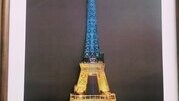Фото-рельєф створений педагогами школи 76
 Фото-рельєф створений педагогами школи № 76 для вернісажу V експозиція "Освітянської АРТ-резиденції", яку проводить КУ "ЦПР "Освітня траєкторія" ДМР, під гаслом "Світ підтримує Україну"
Фото-рельєф створений педагогами школи № 76 для вернісажу V експозиція "Освітянської АРТ-резиденції", яку проводить КУ "ЦПР "Освітня траєкторія" ДМР, під гаслом "Світ підтримує Україну"Ейфелева вежа
У 1889 році в Парижі мала пройти Всесвітня виставка. Вона була приурочена до 100-річчя Французької революції. Адміністрація міста запропонувала відомим інженерам взяти участь в архітектурному конкурсі, де потрібно було показати технологічні досягнення країни. Проект 300-метрової вежі запропонував співробітник інженерного бюро Гюстава Ейфеля – Моріс Кёшлен, а допрацював ескіз – Еміль Нугье. Потім права на створення Ейфель повністю викупив. Архітектурний вигляд доробив Стефан Совестр.
Будівництво проходило з 1887 по 1889 роки. Вхід на виставку проходив через вежу. Через 10 років були встановлені ліфти, за яким до сих пір возять туристів, замінивши лише стару технологію на електродвигуни. Спочатку в договорі з творцем говорилося про демонтаж конструкції вже через 20 років, але вона була так популярна і швидко окупилася, що її вирішили залишити. З 1906 року в ній розміщувалася радіостанція. З 1935 року звідси стали транслювати телевізійні програми. У наш час – це головна пам’ятка Парижа і Франції в цілому.
Металева конструкція важить 7300 тонн з фундаментом з бетону. Всього є три поверхи: нижній – піраміда з 4 колонами і арочним склепінням, друга – така ж, але більш звужена вгорі, а третя завершується куполом з маяком. Продуманість до дрібниць не дозволяє сильно деформуватися споруді під час вітру, але від спеки воно розширюється і стає трохи вище. Під першим балконом можна помітити гравіювання з 72 іменами відомих французьких діячів науки та інженерії.
Окремо варто сказати про штучне освітлення. Вперше воно з’явилося вже в 1889 році. Складалося з 10 000 газових ліхтарів. У 1925 році, в рамках рекламної акції автомобілів Сітроен, тут заграли світлом 125 000 електричних лампочок. Вони зображували знаки Зодіаку, політ комет та інше. У 2003 році поставлено звичне нам освітлення з 20 000 ламп з жовтим відтінком.
Цікаві факти
Гюстав Ейфель називав її «300-метрова вежа», а «Ейфелевою» її прозвали в народі, так назва і залишилася. Ще одне прізвисько – «Залізна дама».
У 1887 році свій протест щодо будівництва об’єкта висловили 300 художників і письменників, які відправили офіційний документ в уряд. Серед них був Гі де Мопассан і Александр Дюма-син.
Для створення конструкції було виготовлено 18038 металевих деталей і 2,5 мільйона заклепок для них.
Зібрати архітектурний шедевр вдалося в короткий термін, це було можливо завдяки детальним кресленням інженера з точністю до 0,1 мм.
Навіть в наші дні пам’ятка є найвищою в Парижі.
Вважається найбільш відвідуваним монументом в світі. Кожен день сюди приходить близько
20 000 чоловік.
При складанні вежі не було жодної припасування – дивовижна точність і для нашого часу.
Вежа до землі ні прикріплена ніяк і зберігає стійкість тільки під дією власної ваги.
Один з найталановитіших аферистів, Віктор Люстіг, в 30-х роках минулого століття спромігся двічі продати вежу на металобрухт.
Eiffel Tower
In 1889, the World Exhibition was to be held in Paris. It was timed to the 100th anniversary of the French Revolution. The city administration invited famous engineers to take part in an architectural competition where it was necessary to show the technological achievements of the country. The project of the 300-meter tower was proposed by Maurice Koechlin, an employee of Gustave Eiffel's engineering bureau, and the sketch was finalized by Emile Nougier. Then Eiffel completely bought the rights to create. The architectural appearance was completed by Stefan Sovestre.
Construction took place from 1887 to 1889. The entrance to the exhibition was through the tower. After 10 years, elevators were installed, which still carry tourists, replacing only the old technology with electric motors. Initially, the contract with the creator stated that the structure would be dismantled after 20 years, but it was so popular and quickly paid off that they decided to leave it. Since 1906, it housed a radio station. Since 1935, television programs have been broadcast from here. Nowadays, it is the main attraction of Paris and France as a whole.
The metal structure weighs 7,300 tons with a concrete foundation. There are three floors in total: the lower one is a pyramid with 4 columns and an arched vault, the second is the same, but more narrowed at the top, and the third ends with a dome with a lighthouse. Thoughtfulness down to the smallest detail does not allow the structure to be greatly deformed during the wind, but from the heat it expands and becomes a little higher. Under the first balcony you can see engravings with 72 names of famous French figures of science and engineering.
It is worth mentioning separately about artificial lighting. It first appeared in 1889. It consisted of 10,000 gas lanterns. In 1925, as part of an advertising campaign for Citroen cars, 125,000 electric bulbs lit up here. They depicted the signs of the Zodiac, the flight of comets, and more. In 2003, the familiar lighting of 20,000 lamps with a yellow tint was installed.
Interesting Facts
Gustave Eiffel called it the "300-meter tower", and the people nicknamed it "Eiffel", so the name remained. Another nickname is "The Iron Lady". In 1887, 300 artists and writers protested the construction of the facility and sent an official document to the government. Among them was Guy de Maupassant and Alexandre Dumas-son.
To create the structure, 18,038 metal parts and 2.5 million rivets were made for them.
It was possible to assemble the architectural masterpiece in a short time, it was possible thanks to the engineer's detailed drawings with an accuracy of up to 0.1 mm. Even today, the landmark is the tallest in Paris.
It is considered the most visited monument in the world. About 20,000 people come here every day.
When assembling the tower, there was not a single adjustment - amazing accuracy even for our time.
The tower is not attached to the ground in any way and remains stable only under the influence of its own weight.
One of the most talented swindlers, Viktor Lustig, managed to sell the tower twice for scrap metal in the 1930s.



